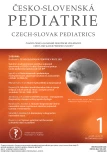Child with VACTERL association – management, diagnostics and treatment of oropharyngeal dysphagia
Authors:
J. Jančíková 1; D. Bezděková 1; M. Urík 1; P. Jabandžiev 2
Authors‘ workplace:
Klinika dětské otorinolaryngologie Fakultní nemocnice Brno a Lékařské fakulty Masarykovy univerzity v Brně
1; Pediatrická klinika Fakultní nemocnice Brno a Lékařské fakulty Masarykovy univerzity v Brně
2
Published in:
Čes-slov Pediat 2021; 76 (1): 42-45.
Category:
Case Report
Overview
VACTERL association is a disorder that affects many body systems. VACTERL stands for vertebral defects, anal atresia, cardiac defects, tracheo-esophageal fistula, renal anomalies, and limb abnormalities. People diagnosed with VACTERL association typically have at least three of these characteristic features. In children with significant perinatal risks, the dysphagia may be present. These children must be treated multidisciplinary. Examination by clinical speech therapist is important. Early rehabilitation of swallowing and orofacial stimulation are necessary for restoring swallowing.
Keywords:
VACTERL association – newborn – dysphagia – multidisciplinary monitoring – clinical speech therapy
Sources
1. Carli D, et al. VACTERL (vertebral defects, anal atresia, tracheoesophageal fistula with esophageal atresia, cardiac defects, renal and limb anomalies) association: disease spectrum in 25 patients ascertained for their upper limb involvement. J Pediatr 2014; 164: 458–462.
2. Chen Y, Liu Z, Chen J, et al. The genetic landscape and clinical implications of vertebral anomalies in VACTERL association. J Med Genet 2016; 53: 431–437.
3. Watanebe, Norikazu, Tsutsumi, Seiji, Miyano, Yki, et al. X-linked VACTERL-H caused by deletion of exon 3 in FANCB: A case report. Congenit Anom (Kyoto) Sep; 2018; 58: 171–172.
4. Van de Putte R, Van Rooij IALM, Marcelis CLM, et al. Spectrum of congenital anomalies among VACTERL cases. EUROCAT population-based study Feb 2020: 541–549.
5. Reddy AKV, Soren C. VACTERL association in a newborn – A rare case report. IOSR J Dental Med Sci 2017; 16: 31–33.
6. Solomon BD. VACTERL/VATER association. Orphanet J Rare Dis 2011; 6 (1): 56. doi:10.1186/17501172-6-56
7. https://www.orpha.net/consor/cgi-bin/OC_Exp.php?Lng=EN&Expert=887.
8. https://atlases.muni.cz/atlases/feto/atl_cz/vacterl.html.
9. Reutter H, Hilger AC, Hildebrandt F, Ludwig M. Underlying genetic factors of the VATER/VACTERL association with special emphasis on the „Renal“ phenotype. Pediatr Nephrol Jan 2016; 31 (11): 2025–2033.
10. Velazquez D, Pereira E, Havranek T. Neonate with VACTERL association and a branchial arch anomaly without hydrocephalus. AJP Rep Mar 2016; 6(1): 74–76.
11. Pilný J, Slodička R, a kol. Chirurgie ruky. Praha: Grada, 2017: 1–449.
12. Solomon BD, Baker LA, Bear KA, et al. An approach to the identification of anomalies and etiologies in neonates with identified or suspected VACTERL. J Pediatr 2014 Mar; 164 (3): 451–457.
13. Wehrman A, Kriegermeier A, Wen J. Diagnosis and management of hepatobiliary complications in autosomal recessive polycystic kidney disease. Front Pediatr 2017; 5: 124.
14. Shastry SM, Kolte SS, Sanagapati PR. Potter‘s sequence. J Clin Neonatol 2012 Jul-Sep; 1 (3): 157–159.
15. Muntau AC. Pediatrie. Praha: Grada, 2009: 358–366.
16. Lebl J, Janda J, Pohunek P, a kol. Klinická pediatrie. Praha: Galén, 2012: 288, 386.
17. Mirra V, Maglione M, DiMicco LL, et al. Longitudinal follow up of chroninic pulmonary maniestations in esophageal atresia: a clinical algorithm and review of the literature. Pediatr Neonatol Feb 2017; 58: 8–15.
18. Hawdon JM, Beauregard N, Slattery J, Kennedy G. Identification of neonates at risk of developing feeding problems in infancy. Dev Med Child Neurol 2000; 42 (4): 235–239.
19. Pridham K, Steward D, Thoyre S, et al. Feeding skill performance in premature infants during the first year. Early Hum Dev 2007; 83 (5): 293–305.
20. https://www.orpha.net/consor/cgi-bin/OC_Exp.php?Lng=EN&Expert=887.
21. Silva-Munhoz LF, et al. Comparison between clinical and videofluoroscopic evaluation of swallowing in children with suspected dysphagia. J CoDAS Apr 2015; 27: 2.
22. Hiorns MP, Ryan MM. Current practice in paediatric videofluoroscopy. Pediatr Radiol 2006; 36 (9): 911–919.
23. Arvedson J, Brodsky L. Pediatric Swalloving and Feeding: Asseesment and Management. Australia, Albany: Singular Publishing, 2002.
24. Castillo Morales R. Die orofaziale Regulationstherapie. München: Pflaum Verlag, 1991.
25. ASHA. Feeding and Swallowing Disorders in Children. ASHA, 2012.
26. Chvílová-Weberová M. Nedonošenost a orofaciální komplex ve vývojových souvislostech. Listy klinické logopedie 2017; 1 (2): 31–39.
27. Solomon BD. VACTERL/VATER association. Orphanet J Rare Dis 2011 Aug; 16: 6.
Labels
Neonatology Paediatrics General practitioner for children and adolescentsArticle was published in
Czech-Slovak Pediatrics

2021 Issue 1
Most read in this issue
- Child with VACTERL association – management, diagnostics and treatment of oropharyngeal dysphagia
- Current diagnostic criteria of neonatal sepsis and systemic inflammatory response in the fetus and the newborn
- Our experience with pediatric inflammatory multisystem syndrome associated with COVID-19 (PIMS-TS)
- Acute myocarditis in adolescents
